What chemical biology is revealing about chronic stress and disease
Chronic stress can lead to changes at the cellular level, resulting in disease. Dr Gabriela Chiosis of New York’s Memorial Sloan Kettering Cancer Center is investigating the chemical pathways behind this process, and how treatments could address the issue
TALK LIKE A CHEMICAL BIOLOGIST
ACUTE STRESS – when a particular event leads to a quick stress reaction that dissipates quickly once the event has passed
CHAPEROME – the collective name for the proteins in a cell that ensure the other proteins have the correct structure for their function
CHAPERONE – proteins that assist the folding of other proteins so they can work correctly
CHEMICAL BIOLOGY – a branch of science where appropriately tailored chemicals are used to enable the study of biological processes
CHEMICAL PROBE – a small molecule that has been modified to highlight or influence a particular cellular function
CHRONIC STRESS – a long-term negative response to ongoing stressors on the body
EPICHAPEROME – a malfunctioning chaperome, that leads to misassembled proteins in the cell and can facilitate the emergence of disease
Stress is not just something we experience mentally; it can lead to physical changes in the body, and even initiate the emergence of disease. “There are two broad types of stress: acute and chronic,” explains Dr Gabriela Chiosis of the Memorial Sloan Kettering Cancer Center in New York, USA. “Acute stress is typically beneficial – for an immediate problem, it makes us more alert and primes us to take action. Chronic stress, on the other hand, lasts longer, and our ability to deal with it collapses to the point it affects our health.”
Many different factors – or stressors – can cause chronic stress. These can include elements of a stressful lifestyle, such as a fast-paced job or financial difficulties, but can also include long-term diseases or other conditions that put strain on our body. All of these can cause changes at the cellular level, which is the focus of Gabriela’s research.
THE CHAPEROME
Every one of our cells contains innumerable proteins, each of which has a specific role to play. About 10% of the proteins in a cell are chaperones – collectively called the chaperome – which ensure that newly-created proteins take on the correct shape to fulfil their function. Chaperones help new proteins fold correctly, help refold misfolded proteins, and regulate disposal of any irreparably misfolded proteins.
However, chronic stress can lead to changes in the chaperome, turning it from a help to a hindrance. “A stressor can trigger this collection of proteins to change to the epichaperome, which no longer helps with protein folding, and can make proteins interact incorrectly,” says Gabriela. “This sets off a chain of events that means a host of proteins no longer work properly, leading to changes in cell behaviour.” A mis-assembly of proteins like this can easily become the basis for diseases like cancer and also neurodegenerative disorders like Alzheimer’s disease.
CHEMICAL BIOLOGY
“Chemical biology is an emerging field and has only really been recognised in the last few decades,” says Gabriela. Her work involves creating completely novel chemicals that can be inserted into cells to detect or affect the epichaperome. “We make unique chemicals that we add to cells, without affecting the cells’ native state,” she says. Gabriela’s training in chemistry helps her visualise the shape and properties of chemicals that may never have existed before she synthesises them. “Science involves a lot of creativity and innovation,” she says. “I have always been driven to try things that challenge me.”
“We make chemical probes that can detect the epichaperome in the human body,” explains Gabriela. “By labelling these chemicals with fluorescence or a particular radio tag, you can then scan the patient to see where these chemicals – and thus the epichaperome – are showing up in the body.” The presence of the epichaperome is an indicator of disease. The magnitude and location of the signal in the body gives an indication of the type of disease, such as different cancers or Alzheimer’s. These chemicals – manufactured in Gabriela’s lab – are becoming an important diagnostic tool in medicine.
DIAGNOSIS AND TREATMENT
As well as simply detecting the epichaperome, these chemical tools are also uncovering the specific changes that proteins undergo when exposed to chronic stress. These changes are many and varied, and can include changes to cellular processes such as the manufacture of new proteins and the controlled destruction of faulty cells. This technique also helps to identify the stressors that led to the condition in the first place. Together, this information helps piece together which stressors lead to what diseases, and why.
These chemical biology tools can also prove useful in developing new drugs and treatment strategies. Gabriela’s lab has successfully invented and disseminated a number of drug candidates. For instance, it has created a chemical that inhibits one of the key proteins within the epichaperome, but only when it is within the epichaperome and not when it is performing useful functions elsewhere in the cell. This helps to mitigate the damage that the epichaperome is causing to the body and, as a result, slow or stop the growth of cancer.
NEW FINDINGS FOR MEDICINE
Gabriela and her team investigated the link between epichaperomes and cancer, which led to some interesting conclusions. “Cancers are dependent on epichaperomes to different degrees, but this is not defined by type of cancer – say, brain or breast cancer,” says Gabriela. “Rather, there are groups within each type of cancer that behave differently.” Clinical trials address cancer by type, but Gabriela is in favour of a move towards ‘basket trials’, where patients are grouped depending on the changes seen at the cellular level rather than the location of the cancer.
Currently, Gabriela’s team is looking into the roots of Alzheimer’s disease. “Alzheimer’s can start decades before patients show neurological symptoms, but nobody really knows what causes it,” says Gabriela. “It appears that Alzheimer’s emerges from a combination of stressors, which can be linked to stressful lifestyle traits, infectious diseases, or other conditions such as diabetes.” However, not everyone who experiences these stressors develops Alzheimer’s, so there remain many unknowns, which Gabriela’s team is attempting to address. It is known that neurons are among the cell types most sensitive to internal disruption, which very much includes the effects of the epichaperome. The team’s findings could potentially revolutionise the diagnosis and treatment of Alzheimer’s.
Reference
https://doi.org/10.33424/FUTURUM170
ACUTE STRESS – when a particular event leads to a quick stress reaction that dissipates quickly once the event has passed
CHAPEROME – the collective name for the proteins in a cell that ensure the other proteins have the correct structure for their function
CHAPERONE – proteins that assist the folding of other proteins so they can work correctly
CHEMICAL BIOLOGY – a branch of science where appropriately tailored chemicals are used to enable the study of biological processes
CHEMICAL PROBE – a small molecule that has been modified to highlight or influence a particular cellular function
CHRONIC STRESS – a long-term negative response to ongoing stressors on the body
EPICHAPEROME – a malfunctioning chaperome, that leads to misassembled proteins in the cell and can facilitate the emergence of disease
Stress is not just something we experience mentally; it can lead to physical changes in the body, and even initiate the emergence of disease. “There are two broad types of stress: acute and chronic,” explains Dr Gabriela Chiosis of the Memorial Sloan Kettering Cancer Center in New York, USA. “Acute stress is typically beneficial – for an immediate problem, it makes us more alert and primes us to take action. Chronic stress, on the other hand, lasts longer, and our ability to deal with it collapses to the point it affects our health.”
Many different factors – or stressors – can cause chronic stress. These can include elements of a stressful lifestyle, such as a fast- paced job or financial difficulties, but can also include long-term diseases or other conditions that put strain on our body. All of these can cause changes at the cellular level, which is the focus of Gabriela’s research.
THE CHAPEROME
Every one of our cells contains innumerable proteins, each of which has a specific role to play. About 10% of the proteins in a cell are chaperones – collectively called the chaperome – which ensure that newly-created proteins take on the correct shape to fulfil their function. Chaperones help new proteins fold correctly, help refold misfolded proteins, and regulate disposal of any irreparably misfolded proteins.
However, chronic stress can lead to changes in the chaperome, turning it from a help to a hindrance. “A stressor can trigger this collection of proteins to change to the epichaperome, which no longer helps with protein folding, and can make proteins interact incorrectly,” says Gabriela. “This sets off a chain of events that means a host of proteins no longer work properly, leading to changes in cell behaviour.” A mis-assembly of proteins like this can easily become the basis for diseases like cancer and also neurodegenerative disorders like Alzheimer’s disease.
CHEMICAL BIOLOGY
“Chemical biology is an emerging field and has only really been recognised in the last few decades,” says Gabriela. Her work involves creating completely novel chemicals that can be inserted into cells to detect or affect the epichaperome. “We make unique chemicals that we add to cells, without affecting the cells’ native state,” she says. Gabriela’s training in chemistry helps her visualise the shape and properties of chemicals that may never have existed before she synthesises them. “Science involves a lot of creativity and innovation,” she says. “I have always been driven to try things that challenge me.”
“We make chemical probes that can detect the epichaperome in the human body,” explains Gabriela. “By labelling these chemicals with fluorescence or a particular radio tag, you can then scan the patient to see where these chemicals – and thus the epichaperome – are showing up in the body.” The presence of the epichaperome is an indicator of disease. The magnitude and location of the signal in the body gives an indication of the type of disease, such as different cancers or Alzheimer’s. These chemicals – manufactured in Gabriela’s lab – are becoming an important diagnostic tool in medicine.
DIAGNOSIS AND TREATMENT
As well as simply detecting the epichaperome, these chemical tools are also uncovering the specific changes that proteins undergo when exposed to chronic stress. These changes are many and varied, and can include changes to cellular processes such as the manufacture of new proteins and the controlled destruction of faulty cells. This technique also helps to identify the stressors that led to the condition in the first place. Together, this information helps piece together which stressors lead to what diseases, and why.
These chemical biology tools can also prove useful in developing new drugs and treatment strategies. Gabriela’s lab has successfully invented and disseminated a number of drug candidates. For instance, it has created a chemical that inhibits one of the key proteins within the epichaperome, but only when it is within the epichaperome and not when it is performing useful functions elsewhere in the cell. This helps to mitigate the damage that the epichaperome is causing to the body and, as a result, slow or stop the growth of cancer.
NEW FINDINGS FOR MEDICINE
Gabriela and her team investigated the link between epichaperomes and cancer, which led to some interesting conclusions. “Cancers are dependent on epichaperomes to different degrees, but this is not defined by type of cancer – say, brain or breast cancer,” says Gabriela. “Rather, there are groups within each type of cancer that behave differently.” Clinical trials address cancer by type, but Gabriela is in favour of a move towards ‘basket trials’, where patients are grouped depending on the changes seen at the cellular level rather than the location of the cancer.
Currently, Gabriela’s team is looking into the roots of Alzheimer’s disease. “Alzheimer’s can start decades before patients show neurological symptoms, but nobody really knows what causes it,” says Gabriela. “It appears that Alzheimer’s emerges from a combination of stressors, which can be linked to stressful lifestyle traits, infectious diseases, or other conditions such as diabetes.” However, not everyone who experiences these stressors develops Alzheimer’s, so there remain many unknowns, which Gabriela’s team is attempting to address. It is known that neurons are among the cell types most sensitive to internal disruption, which very much includes the effects of the epichaperome. The team’s findings could potentially revolutionise the diagnosis and treatment of Alzheimer’s.
 DR GABRIELA CHIOSIS
DR GABRIELA CHIOSIS
Chiosis Lab, Memorial Sloan Kettering Cancer Center, New York, USA
FIELD OF RESEARCH: Chemical Biology
RESEARCH PROJECT: Taking a unique chemical biology approach to understand, diagnose, and treat cellular processes associated with chronic stress
FUNDER: This work was supported by the National Institute on Aging under award numbers R01 AG067598 and R56 AG072599.
 DR GABRIELA CHIOSIS
DR GABRIELA CHIOSIS
Chiosis Lab, Memorial Sloan Kettering Cancer Center, New York, USA
FIELD OF RESEARCH: Chemical Biology
RESEARCH PROJECT: Taking a unique chemical biology approach to understand, diagnose, and treat cellular processes associated with chronic stress
FUNDER: This work was supported by the National Institute on Aging under award numbers R01 AG067598 and R56 AG072599.
ABOUT CHEMICAL BIOLOGY
Chemical biology is an emerging discipline that uses chemical tools to investigate biological processes, learns how these processes go awry in disease, and uses this learning to discover and, potentially, develop treatments for disease. Gabriela explains more.
HOW IS CHEMICAL BIOLOGY DIFFERENT TO RELATED FIELDS, SUCH AS CELL BIOLOGY, GENETICS, AND BIOCHEMISTRY?
Chemical biologists have a unique toolkit for finding answers to cellular problems that other disciplines cannot address in the same way. For instance, we use chemical tools to identify and understand diseases, without having to modify cells.
HOW IMPORTANT IS COLLABORATION IN YOUR FIELD?
Chemical biology starts with chemists, who make the chemical probes. Then, other lab members will have expertise in biochemistry and cell biology, which they apply to chemical biology to identify disease mechanisms and develop drugs or diagnostics. People with expertise in bioinformatics can amplify the work we do – they develop ways of examining thousands of proteins using our methods. We are a small lab, so lots of collaboration involves working with other institutions – and there are plenty of high-quality universities and medical centres in New York and further afield that we enjoy working with.
HAVE THERE BEEN ANY EUREKA MOMENTS IN YOUR RESEARCH?
I think science is all about eureka moments! They are what keep you motivated, interested and dedicated because science is not an easy job. There are two types of eureka moment, I believe. The first is the scientific discovery, which can happen relatively often, but takes a long time to bring results in the real world. The second is when these results start to materialise. For instance, recently a patient called me and thanked me for the extra years of life they had been gifted thanks to a drug I discovered. That is what matters.
WHAT DO YOU FIND REWARDING ABOUT YOUR WORK?
It’s always exciting to see when years of research culminate in advances in the clinic. This can be a long process – sometimes, the time between discovering a new chemical probe and it being used by doctors can be fifteen years or so. I have learnt many things beyond science to promote my inventions and become an entrepreneur, to push this process as much as possible.
WHAT CHALLENGES WILL FACE THE NEXT GENERATION OF CHEMICAL BIOLOGISTS?
Chemical biology is very broad, which is part of its allure. It really is a field of open and endless opportunity. The same applies for related fields – biology, biomedicine, medicine, all are changing so fast, and many doors are opening.
WHAT ARE THE NEXT STEPS FOR YOUR RESEARCH?
At the moment, I am very interested in understanding the mind, and in particular what leads to Alzheimer’s. Understanding the underlying stressors and cellular processes, and why different people have different levels of vulnerability, will be my goal for at least the next few years.
EXPLORE A CAREER IN CHEMICAL BIOLOGY
• The Memorial Sloan Kettering Cancer Center, where Gabriela works, offers a number of programmes for young people. These include an annual seminar and an eight-week summer experience for high school students interested in biomedical sciences.
• This article explains more about what chemical biology entails as a career.
Chemical biology is an interdisciplinary field, and draws on many other areas of science, namely chemistry, biology, biochemistry and medicine. To pursue an undergraduate degree in any of these areas, sensible subjects to take at school include chemistry, biology and mathematics.
Chemical biologists can work in fields such as academia, biotechnology and medicine. A degree in a relative science subject is essential, and often further study is recommended. For instance, Gabriela has an undergraduate degree in biomedical sciences and a PhD in organic chemistry.
Gabriela also emphasises that creativity forms a large part of her work, so arts or humanities subjects can help balance these skills.
HOW DID GABRIELA BECOME A CHEMICAL BIOLOGIST?
WHAT WERE YOUR INTERESTS AS A CHILD?
I was always an avid reader and especially enjoyed poetry. I also loved sports, and played basketball at college. But science has always been my main interest – at school I was very good at mathematics but also wanted to use my creativity and imagination, which led to me choosing biomedical sciences.
WHAT HAS MADE YOU SUCCESSFUL AS A SCIENTIST?
Believing in myself and pursuing my dreams relentlessly!
HOW DO YOU SWITCH OFF FROM YOUR WORK?
I like to be able to switch off completely. When I was younger, this involved going to art galleries, listening to music, or playing sports, and now it is gardening and spending time in nature. I think this balance is important, for maintaining high performance in your work and also your wider life.
WHAT ARE YOUR PROUDEST CAREER ACHIEVEMENTS?
I have been able to overcome obstacles and become who I am. I realised this when I graduated from Columbia University and my mother told me she was happy I could become what she could never be. It made me see that not everyone can follow their calling – and it hasn’t been easy for me either, but determination has seen me through.
GABRIELA’S TOP TIPS
01 Get to know yourself. Aim for what you are best at and what you enjoy, rather than aiming for a career that doesn’t inspire you.
02 Never listen to naysayers – believe in yourself!
Do you have a question for Gabriela?
Write it in the comments box below and Gabriela will get back to you. (Remember, researchers are very busy people, so you may have to wait a few days.)


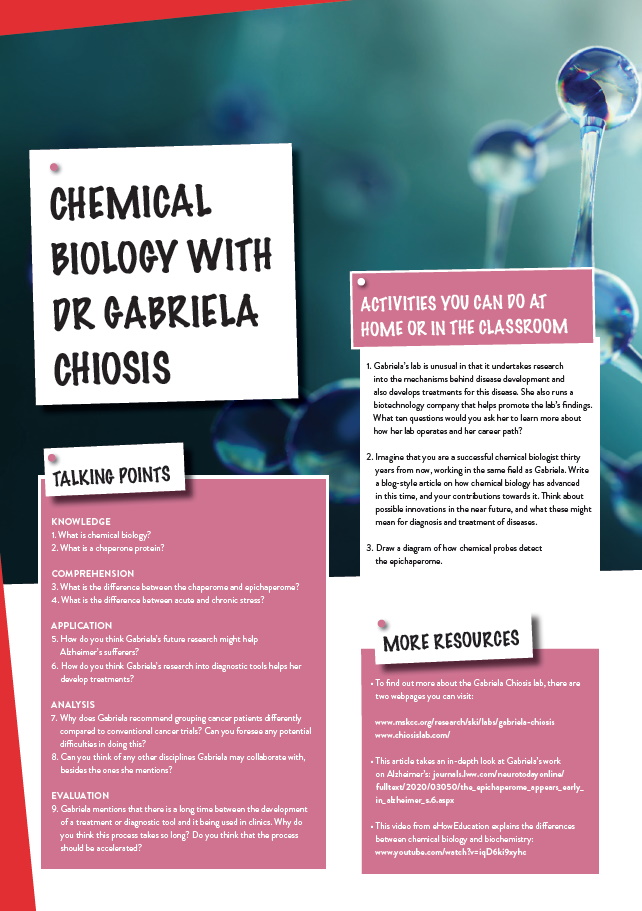
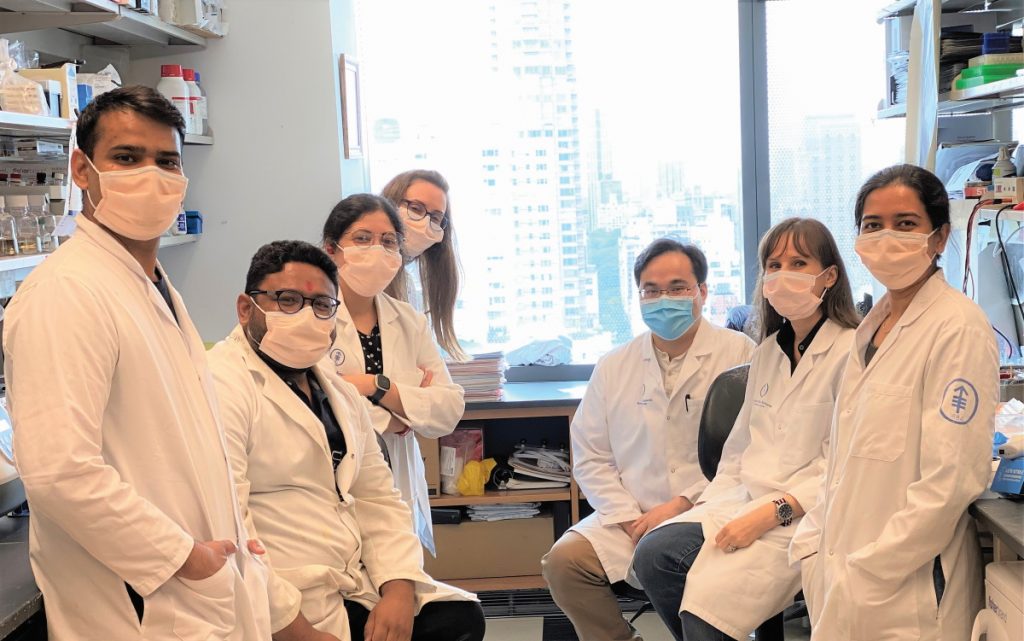

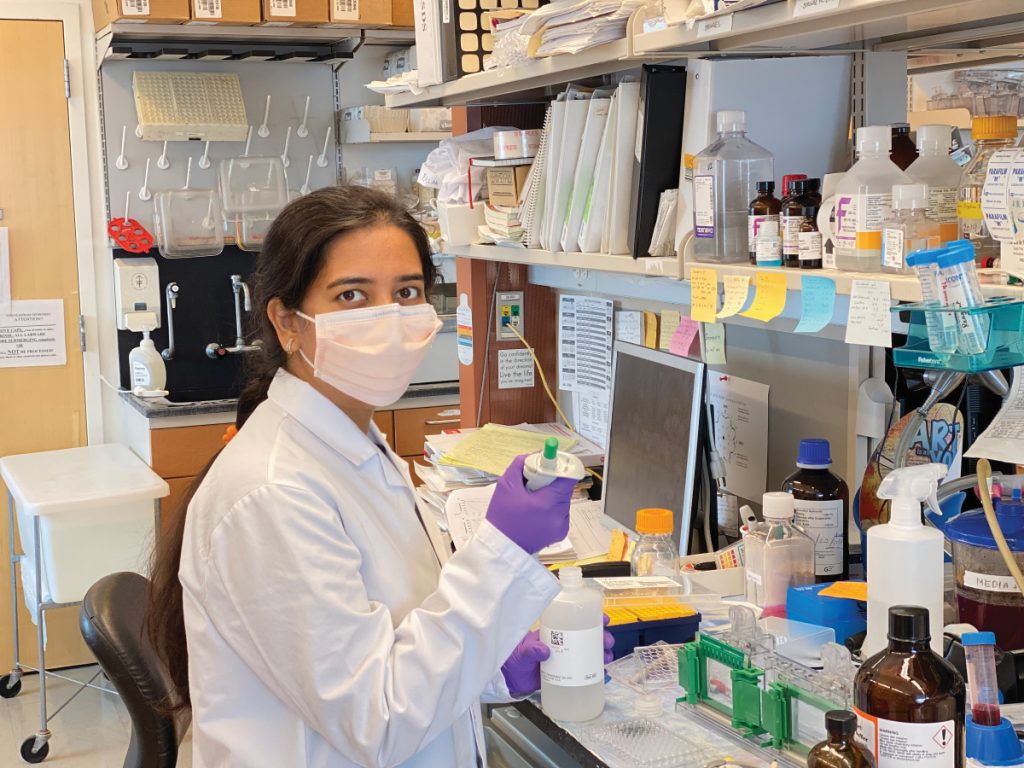


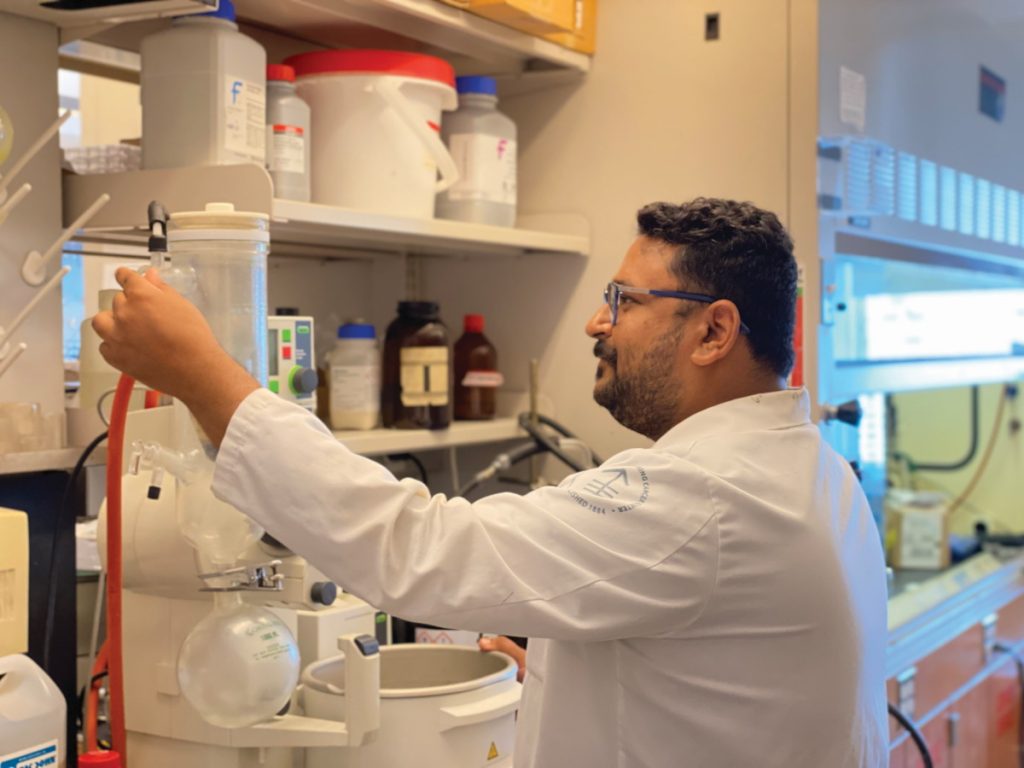
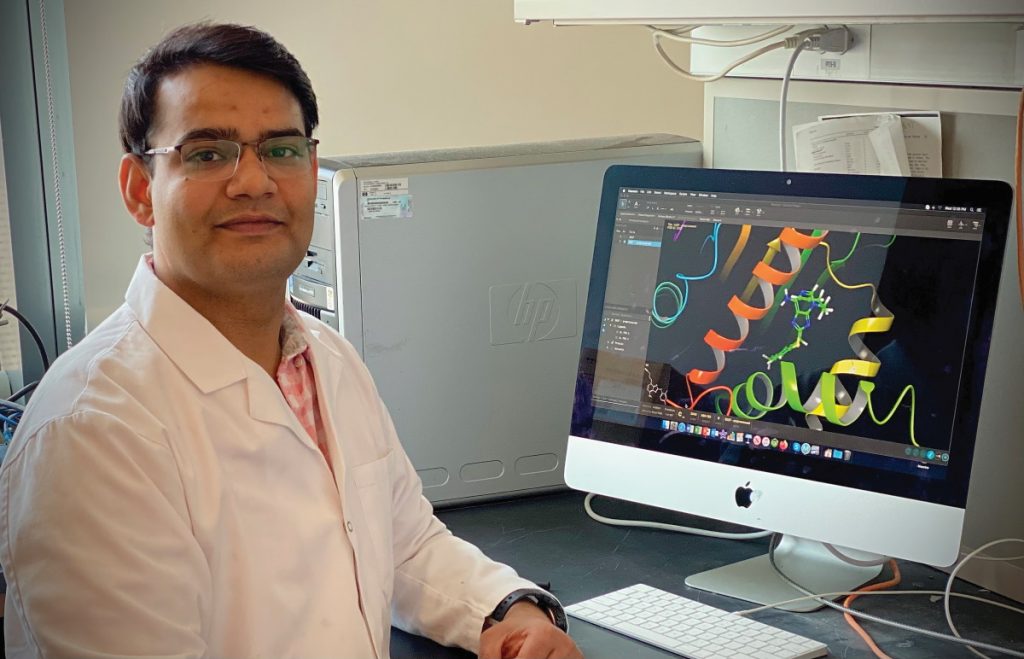
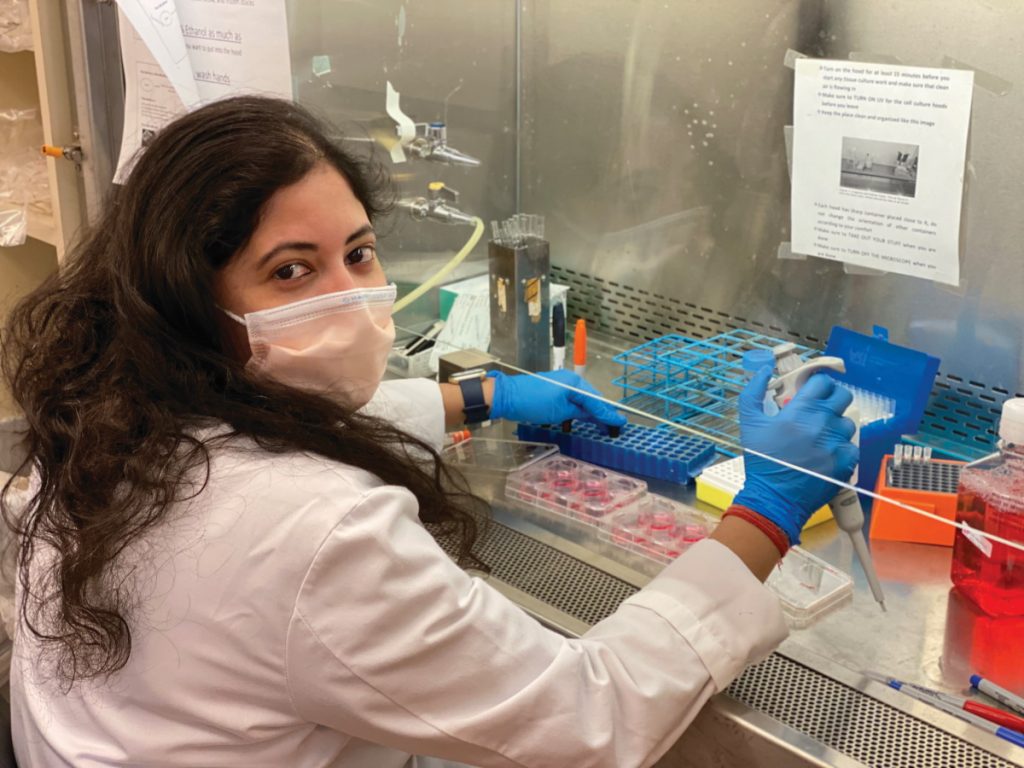
Dear Dr
My simple question is that can you identify a marker protein generated in tumor with size less than 4 mm and respective change in eye iris pattern as an early detection of solid tumor?. This could be simple and versatile method of cancer diagnosis. Dr Afzal Hussain
Hi Gabriel,
I am really interested to work in the field of chemical biology and chemistry. Previously I have worked on protein engineering and protein polymer conjugation. If you have any opening for a staff scientist position then please let me know. I will be really interested to work with you to explore the stress related biomarkers by using my knowledge of organic chemistry and chemical biology.
PS: I have more than ten years knowledge in organic synthesis and purification. More than five knowledge of cell biology techniques like cell culture, protein expression, site specific mutation, recombinant protein technology, protein purification and characterization by LCMS and MALDI. Site specific protein labelling and peptide synthesis.
my google scholar profile:
https://scholar.google.com/citations?user=SJ8xqPMAAAAJ&hl=en
Linkedin profile:
https://www.linkedin.com/in/partha-sarathi-addy-ph-d-8325961a/
Hi Dr Addy,
I am afraid this is not a job or recruitment website. Please get in touch with the academic featured in this article directly via their university.
Many thanks,
Futurum Webmaster
Imagine that you could have a detailed lifestyle description of a healthy cohort of men and women, aged 50 and older. It would include their levels of hsp 27, 60, 70, and 90 and whether mutations exist; the activity of genes associated with increased levels of healthy hsps 70 & 90 and reduced risk of developing cancer and Alzheimer’s; their clinical results — blood, urine , and other biomarkers; their gut, nasal, and oral microbiome content — analysed via NGS to the species levels.
Would this help you and your research colleagues develop effective drugs that could counter Hsp mutations? Could it help reduce the recurrence of disease among PU-AD and/or PU-H71 trial participants?